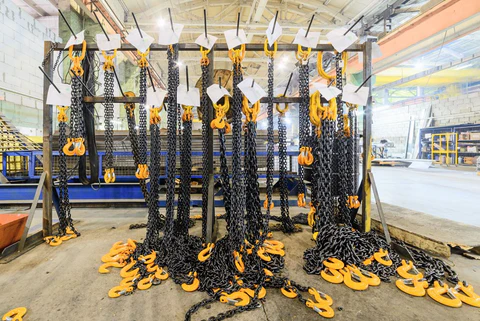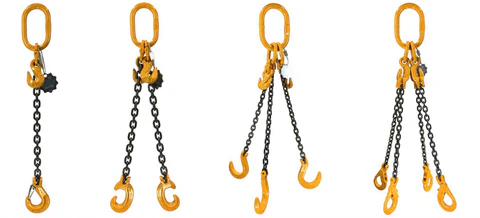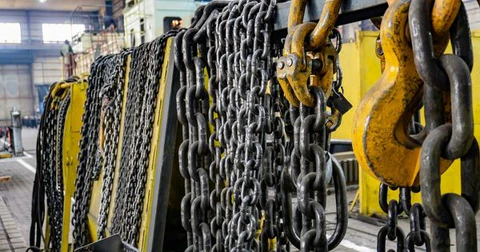# A Comprehensive Guide to Chain Slings
Chain slings are indispensable tools in lifting operations, offering a secure and reliable way to handle heavy loads. Whether you're working in construction, manufacturing, or logistics, chain slings are a must-have for anyone looking to move large or cumbersome items safely and efficiently. This detailed guide will explore the fundamentals of chain slings, their significance in lifting operations, how to choose the right one for your needs, best practices for their use and maintenance, and essential inspection routines.

## Getting to Know Chain Slings
To fully grasp the role chain slings play in lifting operations, it’s important to understand what they are. Essentially, chain slings are made up of metal chains, usually crafted from alloy steel, designed to lift loads of varying weights and dimensions. These chains consist of multiple interconnected links that form a robust and resilient lifting mechanism.
Chain slings have been a cornerstone in the lifting and rigging industry for hundreds of years. The use of metal chains for lifting dates back to ancient times when rudimentary versions of chain slings were made from simple materials. With advances in metallurgy and engineering, modern chain slings are now highly specialized, capable of withstanding immense weights and enduring harsh conditions.
### What Are Chain Slings?
Chain slings are versatile lifting devices that can be used across a wide range of industries and applications. They are frequently found in construction sites, manufacturing plants, and transportation hubs. Known for their exceptional strength and durability, chain slings are ideal for lifting heavy loads in challenging environments.
One of the standout features of chain slings is their ability to resist abrasion, cutting, and heat. This makes them particularly suited for industries where loads might have sharp edges or be exposed to extreme temperatures. Additionally, chain slings are flexible, allowing them to adapt to the shape of the load being lifted, ensuring a stable and secure lifting solution.
### Types of Chain Slings
There are several types of chain slings available, each tailored to specific lifting needs. Common varieties include single-leg chain slings, double-leg chain slings, three-leg chain slings, and four-leg chain slings. The choice of chain sling depends on factors such as load weight, lifting angle, and the operational environment.
Single-leg chain slings are perfect for straightforward vertical lifts, whereas double-leg and multi-leg chain slings are better suited for complex lifting scenarios where balance and stability are critical. The adaptability of chain slings makes them a popular choice for lifting operations requiring precision and dependability.

## The Importance of Chain Slings in Lifting Operations
Chain slings are essential in heavy lifting operations, ensuring worker safety and the integrity of the load being lifted. Their capacity to handle heavy loads and endure harsh conditions makes them an irreplaceable asset in numerous industries.
For decades, chain slings have been a mainstay in the lifting and rigging industry, providing a dependable and durable solution for moving heavy objects. The design of chain slings, typically made from alloy steel, allows them to resist abrasion, cutting, and impact, making them suitable for demanding lifting tasks.
### The Role of Chain Slings in Heavy Lifting
When it comes to heavy lifting, chain slings provide the necessary strength and reliability to get the job done. Whether you're lifting machinery, construction materials, or other heavy objects, chain slings are built to withstand immense forces and distribute the load evenly for a secure lift.
Chain slings come in various configurations, such as single-leg, double-leg, triple-leg, or quad-leg, offering versatility in different lifting scenarios. The selection of chain sling configuration depends on factors like the weight of the load, the lifting environment, and the required lifting angles.
### Safety Considerations When Using Chain Slings
Ensuring the safety of workers and the surrounding environment is paramount when using chain slings. Proper training on chain sling usage and adherence to safety guidelines are essential. Chain slings should be inspected regularly for signs of wear and tear, and workers should be equipped with appropriate personal protective equipment to minimize the risk of accidents. Regular maintenance of chain slings is crucial to their longevity and safe operation. Lubrication of the chains, checking for distortion or stretching, and monitoring the condition of fittings and attachments are all part of a comprehensive maintenance program. By taking care of chain slings and following recommended practices, the risk of accidents and equipment failure can be significantly reduced.
## Choosing the Right Chain Sling for Your Needs
Selecting the right chain sling is crucial to ensure safe and efficient lifting operations. Several factors should be considered when choosing a chain sling.
When it comes to selecting a chain sling, it’s essential to examine the specifics of your lifting requirements. Factors such as the material of the load, the shape of the load, and the frequency of use all play a significant role in determining the most suitable chain sling for the job. For example, if you’re lifting sharp-edged materials, you may need a chain sling with added protection to prevent damage and ensure longevity.
### Key Considerations When Selecting a Chain Sling
Load weight, lifting angle, and the environment in which the chain sling will be used are all important considerations. Additionally, the type of chain sling and its load capacity must be compatible with the specific lifting requirements. Consulting with a qualified professional is recommended to determine the most suitable chain sling for your needs. Furthermore, the working conditions in which the chain sling will be used should not be overlooked. Factors such as temperature, exposure to chemicals, and the presence of abrasive materials can impact the longevity and performance of the chain sling. It is crucial to select a chain sling that is not only suitable for the load but also capable of withstanding the environmental challenges it will face.
### Load Capacity and Sling Length
Understanding load capacity and sling length is vital to prevent overloading and ensure the chain sling is used within its safe working limits. Exceeding the load capacity or using a chain sling that is too short can lead to accidents and damage the equipment. Consult load charts and follow manufacturer guidelines to accurately determine the suitable load capacity and sling length for your lifting operations.
Moreover, regular inspections and maintenance of the chain sling are imperative to ensure its continued reliability and safety. Inspecting for signs of wear, corrosion, or distortion should be part of your routine maintenance schedule to detect any issues early and prevent potential accidents during lifting operations.

## Proper Use and Handling of Chain Slings
To maximize the lifespan and functionality of chain slings, proper use and handling are crucial.
In industrial operations involving heavy lifting, chain slings play a vital role in ensuring safety and efficiency. These robust tools are designed to withstand heavy loads and provide a reliable means of lifting and moving objects in various settings, from construction sites to manufacturing facilities.
### Basic Operating Procedures for Chain Slings
Proper operating procedures should be followed when using chain slings, such as attaching the sling securely to the load, ensuring proper balance, and applying suitable lifting techniques. Workers should be trained on the correct usage of chain slings, including avoiding sudden movements, using appropriate lifting tools, and maintaining clear communication during lifting operations.
Additionally, it is essential to consider environmental factors when using chain slings. Extreme temperatures, exposure to chemicals, or rough handling can all impact the performance and safety of the slings. Regular maintenance and inspections are key to identifying any issues early on and ensuring the continued reliability of the equipment.
### Dos and Don’ts of Chain Sling Handling
There are certain dos and don’ts when it comes to handling chain slings. Dos include conducting regular inspections for signs of wear, storing chain slings properly when not in use, and regularly lubricating the chain links for smooth operation. It is also important to follow manufacturer guidelines for safe working loads and usage limits to prevent accidents and equipment damage.
On the other hand, don’ts include overloading the chain sling, twisting or knotting the chain links, or exposing the chain sling to corrosive substances without appropriate protective measures. These actions can compromise the integrity of the sling and pose serious risks to both personnel and property. By adhering to best practices and safety protocols, workers can ensure the effective and safe use of chain slings in various lifting applications.

## Maintenance and Inspection of Chain Slings
Regular maintenance and inspection practices are vital to keep chain slings in optimal working condition.
### Routine Inspection and Maintenance Practices
Chain slings should be inspected regularly by trained personnel to identify signs of wear, such as elongation of chains, damaged links, or worn-out hooks. Any damaged or worn parts should be replaced immediately. Additionally, regular maintenance, including cleaning and lubrication, should be performed to extend the lifespan of the chain sling and ensure its safe operation.
### Identifying Signs of Wear and Tear
It is important to be aware of common signs of wear and tear in chain slings. These include elongation or stretch in the chains, visible cracks or deformations in the links, and signs of corrosion. Any signs of wear and tear should be addressed promptly to prevent equipment failure and potential accidents.
## Conclusion
In summary, chain slings are indispensable tools in lifting operations, offering strength, durability, and reliability. Understanding the basics of chain slings, their importance in lifting operations, selecting the right chain sling, and following proper use, handling, maintenance, and inspection practices are crucial for safe and efficient lifting operations. By following these guidelines, you can ensure the longevity and effectiveness of your chain slings, while prioritizing the safety of workers and the success of your lifting operations.
Refrigeration Units Mounting Kit
Chongqing Wishcarry Trade Co.,Ltd. , https://www.wishcarry-cooler.com
